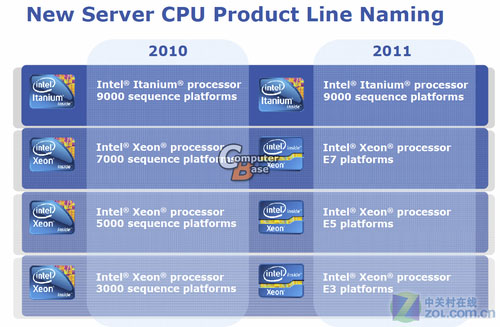 The x86 server market has been continuously innovated with the development of Intel Xeon processors. With the successful promotion of the 32nm Xeon 5600 series products last year, users have expectations for chip technology under Moore's Law. It is reported that a new generation of Intel Xeon processors will adopt new naming rules, which will add a mystery to the Xeon processors under the Sandy Bridge architecture. Recently, the roadmap of the latest Intel Xeon processors exposed abroad shows the prospects of the Sandy Bridge architecture in the server field.
The x86 server market has been continuously innovated with the development of Intel Xeon processors. With the successful promotion of the 32nm Xeon 5600 series products last year, users have expectations for chip technology under Moore's Law. It is reported that a new generation of Intel Xeon processors will adopt new naming rules, which will add a mystery to the Xeon processors under the Sandy Bridge architecture. Recently, the roadmap of the latest Intel Xeon processors exposed abroad shows the prospects of the Sandy Bridge architecture in the server field. The new generation of Xeon processors has a regular relationship with the previously introduced Xeon 3000, 5000, 7000 series and Itanium series. The low-end Xeon E3 processor corresponds to the previous Xeon 3000 series products, Xeon E3-1200 series processor specifications, and some of the specifications of the C202, C204, and C206 server chip sets that were used with it were introduced before. The chipset uses Intel Active Management Technology 7.0 to support state management, hardware and software lists, alarms, and remote configuration.
Intel uses the interface form LGA-1155 Xeon E3 processor will have many different models to enrich the market. Intel will provide TDP at 95, 80, 45 or even 20W processor models. In addition to the integrated HD 2000 graphics card model E3-1260L, there are 4 other processors integrated with HD 3000 graphics in the 11 models.
With the success of the Xeon 7500 processor in the high-end server segment, a Xeon Westmere-EX processor targeted for multi-processor servers will be introduced in the first half of 2011. Although not a Sandy-Bridge architecture, it is in the manufacturing process and core Volume, cache capacity, and other aspects have made great progress.
The Xeon 7500 successor Westmere-EX has a lot of technical changes that not only improve the L3 cache capacity to 30MB and the integrated memory controller number of 32GB, but also have enhanced virtualization support in virtualization, which will enhance the virtual machine Switch speeds, add Real mode functionality, reduce latency and response time, and improve RAS features.
According to foreign disclosures, Intel's new processor for multi-server servers will be named Xeon E7 series, including two sub-series: Xeon E7-2800 for two-way servers, Xeon E7-4800 for four-way servers.
It can be seen from the naming that the Xeon E7 series (Westmere-EX) is a new processor to replace the current Xeon 7500 (Nehalem-EX) product. According to Intel's roadmap, the Xeon E7-2800 series has a six Core, two eight cores, and three types of ten cores, starting at 1.73GHz, three-level cache ranging from 18-30MB, TDP to 105W or 130W.
According to statistics, the Xeon E7-4800 series core distribution and L3 cache capacity range from 18-30MB, but the takeoff frequency increases to 1.83GHz, but the minimum thermal design power consumption is only 95W. In addition there is at least one low-power ten-core Xeon E7-8867L, thermal design power consumption is only 105W, the frequency is still 2.13GHz, three-level cache also retains all 30MB, QPI bus frequency is full-speed 6.4GT / s.
others
Guangzhou Lufeng Electronic Technology Co. , Ltd. , https://www.lufengelectronics.com
